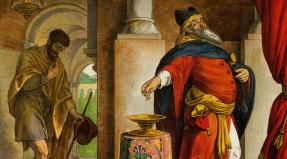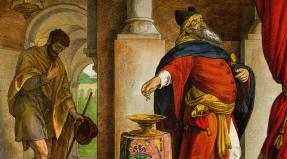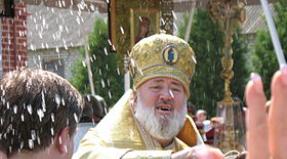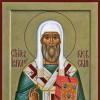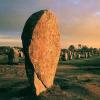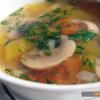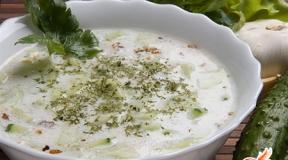Key dates in the life of robert burns. R. Wright-Kovaleva. Robert Burns Key dates in the life of Robert Burns Burns chronological table
1765 - Robert and brother Gilbert go to Murdoch's school.
1766 - Transfer to the Mount Oliphant farm.
1773 - Robert writes the first poems of "Nelly".
1775 - the school in Karkoswald and the poem "Prophesies of the coming of autumn."
1777 - Moving to Lokhli farm.
1779 - the first poems read at Tarbolton.
1780 - organization of the Club of Bachelors. Distribution of poems and songs.
1781 - the beginning of the lawsuit between the father and McLure. Drive to Erwin.
1752 - acquaintance with Richard Brown. Return to Lochli.
1783 - the first "Notebook";
autumn- Old Man Burns's appeal to the Supreme Court; acquaintance with Hamilton and Aiken.
summer- Robert meets Jean;
summer and in the fall this year, "The Merry Beggars" and many other verses were written;
November- the death of a brother. Poems "Field Mouse".
1786 - travel plans to Jamaica;
April- brochures of the "Kilmarnock volume";
old man Armor learns about Robert and Jean's secret marriage;
Jean's “betrayal”;
July- Robert transfers rights to Mossgill Farm to Brother Gilbert;
November- Burns goes to Edinburgh.
May- a trip to Scotland;
August - completed letter to Dr. Moore;
August- September- work on the "Musical Museum", a trip to the Highlands of Scotland with William Nick;
October- return to Edinburgh.
February- a trip to Ellisland with a friend of his father;
March- a trip to Edinburgh. Conclusion of a contract for the lease of Ellisland farm. Publication of the second volume of the "Musical Museum";
May- homecoming. Burns is taking a course on how to work excise;
June- July - Burns lives in Ellisland, builds a house.
1789 , February- Burns in Edinburgh finishes copyright settlement with Creech;
July- acquaintance with Grose;
September- commencement of service in excise duty.
1790, February- the release of the third volume of the "Musical Museum"; December- The manuscript of "Tam O" Shenter was sent to Grose.
August- sale of livestock and equipment in Ellisland;
November- The Burns family moves to Dumfries.
1792 - appointment to the port inspection;
March- April- disarmament of a smuggling schooner and purchase of four mortars;
March- the release of Payne's book "Human Rights";
May- Payne's departure to France. Banning his book;
August- the release of the fourth volume of the "Musical Museum";
September- the beginning of work for the publication of Thomson "Selected Scottish Melodies"; the opening of a new theater in Dumfries;
December - first convention of Friends of the People in Edinburgh;
1793 - the execution of the French king;
February- the second Edinburgh edition of poems is published in two volumes. Burns receives twenty copies of the book in royalties;
May - moving to a new house (in Melnichny lane); June- the first volume of "Selected Scottish Melodies" was released;
July- August- a trip with Syme in County Galloway:
arrests and trial of Friends of the People in Edinburgh.
1794 - a quarrel with the Riddels;
May- Burns refusal to work in a London newspaper;
June - second trip with Syme;
December- promotion in excise duty.
1795 - Burns joins the Dumfries Volunteers. The height of correspondence with Thomson about Scottish folklore;
December- Severe Burns disease.
1796 , March- food riots in Dumfries;
July- Burns at the Brow Wells resort;
Robert Burns (January 25, 1759 - July 21, 1796) - Scottish poet, folklorist and author of numerous works written in the "Plain Scottish" language. On his birthday - January 25 - it is customary in Scotland to prepare a gala dinner with several dishes, which must certainly follow in the order in which they were mentioned by the poet in the poem. The entire event is accompanied by traditional bagpipe tunes and recitations of Burns' most famous quatrains.
Childhood
Robert Burns was born on January 25 in the village of Alloway, located near Ayrshire, Ayrshire, into a peasant family. His mother died in childbirth, so only his father was involved in raising his son. However, Robert's childhood cannot be called happy. In order to feed the family (Robert had a younger brother, Gilbert), his father had to rent the Mount Oliphant farm, where he began to work tirelessly.
And since Gilbert was still too young at that time, Robert soon had to join his father. Later, the poet confesses to his friends and colleagues that it was the most difficult childhood of all that he had heard and seen. The boy worked day and night growing grain, fruits and vegetables. In the daytime he was in the field, and at nightfall, having rested only a couple of hours at sunset, he began to clean the stables and barns, where his father kept cattle for sale and work. The hellish work, of course, left an indelible mark on the boy's heart and subsequently was reflected more than once in his works.
Youth and the beginning of a poetry career
As a young man, Robert begins to write poetry for the first time. Despite all the hardships and hardships, they come out rather bright and even naive, but the young talent is embarrassed to show them to anyone, because he is an ordinary peasant boy with no education.
In 1784, Robert experiences his first loss. His father dies, leaving the entire household to his two sons. However, after a few months, both young men understand that they cannot do anything on their own, since they are practically not trained in managing such a household, apart from the dirtiest, dirty cleaning work. So they sell Mount Oliphant and move to a town called Mossgill.
There, their paths separate. Robert enters the Masonic lodge, which will later be reflected in his work, and brother Gilbert marries one girl and becomes the owner of one of the taverns, which quickly gains popularity thanks to the openness, hospitality and good nature of its owner.
It is here, in Mossgill, that the first works of Robert Burns are published: "John Barleyseed", "Holy Fair", "Merry Beggars" and "Poems mainly in the Scottish dialect". It is thanks to them that the young talent is recognized throughout Scotland.
Moving and going into high society
In 1787, at the insistence of one of his best friends, Robert moved to Edinburgh, where they began to introduce him to people from high society. Despite the fact that in other cities a young and talented guy was quite popular, here in Edinburgh only a few knew about him, which could not but upset the poet. He begins to meet influential people, the first of whom is James Johnson. Very soon, Robert becomes aware that his new best friend has been collecting legends, poems and any folklore of Scotland all his life. Seeing a soul mate in a man, Burns invites him to unite and create something like a Scottish cycle. This is how their joint creation, The Scottish Musical Museum, was born, where friends try to collect the most famous motifs and poems from several eras.

Thanks to all the same Jones, they will learn about Robert Burns in Edinburgh, and his poems and cycles of stories are sold in hundreds of copies. This allows the poet to collect a small fee, which he passionately wants to invest in renting one of the estates, as his father did in the past. But, unfortunately, the naive Burns is outwitted, and after an unsuccessful deal, he loses the money he earned, left penniless. After that, he worked for a long time as an excise collector, sometimes starving and several times miraculously escaped from a debt prison.
Throughout his life, Robert Burns manages to write and publish many works that bring him fame. Among them, the most popular are "Ode to the Memory of Mrs. Oswald" (1789), "Tam O'Shenter" (1790), "Honest Poverty" (1795) and many others.
Personal life
Despite the fact that the poet spent half his life in a decent high society, his manners were far from ideal. In particular, this concerned his personal life. Robert Burns was a rather dissolute and freedom-loving person who knew how and loved to use the moments of glory. So, he started many office romances, three of which ended with the appearance of illegitimate children. However, Burns never thought about them and even stopped communicating with their mothers immediately after the birth of their children. Such was the character of a genius.
In 1787, Robert Burns meets a girl named Jean Armor - his first love, which he was infatuated with as a teenager. After a short romance, they get married, and five children are born in the marriage.
In the period 1787-1794, the famous poems "Tam o'Shanter" ("Tam o'Shanter", 1790) and "Honest Poverty" ("A Man's A Man For A 'That", 1795), "Ode to the Memory Mrs. Oswald "(" Ode, sacred to the Memory of Mrs. Oswald ", 1789). In a poem dedicated to John Anderson (1789), the thirty-year-old author suddenly thinks about the end of life, about death.
In fact, Burns was forced to study poetry in between the main work. He spent his last years in need and, a week before his death, almost ended up in a debt prison.
Burns died on July 21, 1796 in Dumfries, where he left already sick on official business 2 weeks before his death. He was only 37 years old. According to biographers of the 19th century, one of the reasons for Burns's sudden death was excessive drinking. Historians of the 20th century are inclined to believe that Burns died from the consequences of hard physical labor in his youth and congenital rheumatic heart disease, which in 1796 was aggravated by diphtheria that he had suffered.
The main dates of the poet's life
- January 25, 1759 - Birth of Robert Burns.
- 1765 Robert and his brother go to school.
- 1766 Moved to Mount Oliphant Farm.
- 1774 Robert writes his first poems.
- 1777 - Moving to Lochly farm.
- July 4, 1781 - Initiated into the Brotherhood of Freemasons at St. David's Lodge No. 174, Tarbolton.
- 1784 - death of his father, moving to Mossgill.
- 1785 - Robert meets Jean, "Merry Beggars", "Field Mouse" and many other poems are written.
- 1786 Burns transfers rights to Mossgill Farm to his brother; birth of twins; trip to Edinburgh.
- 1787 - admission of the poet to the Grand Lodge of Scotland; the first Edinburgh edition of the poems is published; travel to Scotland.
- 1789 - excise duty.
- 1792 - assigned to the port inspection.
- 1793 - Second Edinburgh edition of poems in two volumes.
- December 1795 - Burns is in serious condition possibly related to tooth extraction.
- July 21, 1796 - death
- July 25, 1796 - funeral, on the same day Burns' fifth son, Maxwell, was born.
Burns language
Although Burns studied in a rural school, but his teacher was a man with a university education - John Murdoch (Murdoch, 1747-1824). Scotland was then experiencing a peak of national revival, was one of the most cultural corners of Europe, there were five universities in it. Under Murdoch's direction, Burns studied, among other things, the poetry of Alexander Pope. As evidenced by the manuscripts, literary English language Burns was an impeccable master (wrote on it "Saturday Night of the Villager", "Sonnet to the Blackbird" and some other poems). The use of Scottish in most works ("dialect" of English, as opposed to Gaelic - Celtic Scottish) is a conscious choice of the poet, declared in the title of the first collection of "Poems predominantly in the Scottish dialect".
"Burns stanza"
A special form of stanza is associated with the name of Burns: a six-letter line according to the AAABAB scheme with shortened fourth and sixth lines. A similar scheme is known in medieval lyric poetry, in particular, in Provencal poetry (from the 11th century), but its popularity faded away from the 16th century. It survived in Scotland, where it was widely used before Burns, but is associated with his name and is known as the "Burns stanza", although its official name is a standard gabby, it comes from the first work that glorified this stanza in Scotland - "Elegy to Death Gabby Simpson, Bagpiper of Kilbarhan ”(c. 1640) by Robert Sempill of Beltreeze; "Gabby" is not a proper name, but a nickname for the natives of the town of Kilbarkhan in Western Scotland. This form was also used in Russian poetry, for example, in Pushkin's poems "Echo" and "Collapse".
- January 3, 1891 Osip Mandelstam was born in Warsaw in the family of a merchant.
- 1907 He graduated from the Tenishevsky School in St. Petersburg.
- 1907-1910 Osip Mandelstam listens to lectures in Paris, in 1909-1910 in Heidelberg.
- 1911-1917 studies at the Romano-Germanic department of St. Petersburg University, studying the Old French language and literature (he did not finish the course).
- 1909 Acquaintance with Viach. Ivanov and I. Annensky.
- 1910 Mandelstam's poems first appear in print in the Apollo magazine. In his early poems, the influence of the poetry of the Symbolists is noticeable.
- 1911 Mandelstam became close to NS Gumilev and AA Akhmatova, in 1913 his poems Notre Dame, “Hagia Sophia” were published in the program selection of acmeists.
- 1913 The first book of poems is published - "Stone" (2nd, revised edition, 1916)
- 1914
The first world war Mandelstam first welcomes, then debunks ("Menagerie").
In Mandelstam's post-revolutionary poems, along with the acceptance of the revolution in a general democratic spirit ("January 1, 1924"), the personal theme of "split-off", "the sick son of the century", etc., sounds louder, which leads to the poet's gradual social and literary isolation. - 1919-1922 Mandelstam leaves hungry Petersburg to the south (Ukraine, Crimea, Caucasus: memoirs "Feodosia", 1925), but refuses to emigrate
- 1922 He settles in Moscow with his young wife N.Ya. Khazina (N.Ya. Mandelstam), who will become his support for life, and after the death of her husband will save his legacy. In the same year, Mandelstam's second book, Tristia, was published.
- 1923 The Second Book is published.
- 1924-1928
Since 1924, Mandelstam has lived in Leningrad, since 1928 in Moscow, without having his own home, earning grueling translations.
After 1925, Mandelstam stopped writing poetry for five years; only in 1928 did the final collection "Poems" and the prose novel "The Egyptian Mark" appear. - 1930 Mandelstam writes "The Fourth Prose", the most severe denunciation of the new regime, and in 1933 a poetic invective ("epigram") against Stalin ("We live without feeling the country ..."). This break with the official ideology gives him the strength to return to creativity (with rare exceptions, "on the table", not for print). At this time, the articles "Save my speech ...", "For the explosive valor of the coming centuries ...", "Armenia", essays "Travel to Armenia" (1833), "Conversation about Dante" (1933) were created.
- 1934 Mandelstam was arrested (for the "epigram" and other poems), exiled to Cherdyn in the Northern Urals, after an attack of mental illness and attempted suicide, transferred to Voronezh. There he serves his exile until May 1937, lives almost beggarly, first on small earnings, then on the meager help of friends. Mandelstam is awaiting execution: the unexpected mildness of the sentence evokes mental confusion in him, resulting in a series of verses with an open acceptance of Soviet reality and a readiness for sacrificial death (Stanzas 1935 and 1937, the so-called “ode” to Stalin 1937, etc.); however, many researchers see in them only self-coercion or "Aesopian language". The central work of the Voronezh years "Poems about the Unknown Soldier."
- 1937 After Voronezh, Mandelstam lives for a year in the vicinity of Moscow.
- 1938 Mandelstam is arrested a second time "for counter-revolutionary activities" and sent to Kolyma
- December 27, 1938 Osip Emilievich Mandelstam dies in a transit camp, in a state close to insanity, according to the official conclusion, from heart paralysis.
His name remained banned in the USSR for about 20 years.
Chronological table
1186 Henry VI, son of Emperor Frederick I of Barbarossa, and Constance of Sicily are married in Milan, giving Henry VI the hope of the crown of Sicily.
1187 In October, Sultan Saladin of Egypt conquers Acre, Jerusalem with the Holy Sepulcher. This gave rise to the third crusade.
1189 On May 11, a crusader army led by Frederick I Barbarossa departs from Regensburg. In November, King William of Sicily dies childless - Henry VI claims the throne.
1190 Emperor Frederick I Barbarossa drowns in the Salef River in Asia Minor. Merchants from Lubeck and Bremen found the Teutonic Order in the Holy Land (originally as an order for nursing the sick).
1191 On April 15, Pope Celestine III crowns Henry and his wife Constance as emperor and empress. Henry travels south to conquer Sicily. Due to an epidemic in the German army, the siege of Naples ends. Heinrich also falls ill and returns to Germany. His wife Constance is captured by the Sicilian anti-king Tancred di Lecce. The Hohenzollerns become Counts of Nuremberg.
1192 Conspiracy of princes against Emperor Henry VI with the active participation of Henry the Lion. After the capture of the English king Richard the Lionheart, the conspiracy falls apart. The million-dollar ransom received by Henry VI for the release of Richard the Lionheart so strengthens the power of the emperor that the internal German opposition disappears.
1194 In February, after receiving a huge ransom, Richard the Lionheart is freed by recognizing the emperor as supreme overlord. In February, the Sicilian anti-king Tancred of Leccia dies. On December 25, at the Cathedral in Palermo, Henry VI was crowned King of Sicily. A day later, on December 26, the heir of Henry VI, the future emperor Friedrich I. was born in Jesi in Ancona. Initially, his mother, Constance, named him Constantine, but later the boy was renamed Friedrich Roger in honor of his grandfathers.
1195 At the court council in Bari, Constance is declared regent, and the Germans are appointed to the highest leading positions. In July, Henry VI returns to Germany to settle the issue of succession to the throne and prepare for the promised crusade. In December, he invites the imperial princes to make their imperial fiefs hereditary. In return, Henry VI requires them to agree to the succession to the throne by the Staufens. At first, the princes agree. But a year later, they revoke their consent. From the point of view of political influence, the right to elect a king seems to them more important than inheritance of the fief. On August 6, Heinrich Leo, the main rival of the Staufens, dies in Braunschweig.
1196 In December, the imperial princes elect the emperor's son, Frederick, as king of Germany. The heyday of the cities of Flanders begins. Ghent and Bruges are developing especially rapidly, as well as Venice, Pisa, Milan and Genoa.
1197 German crusaders are already on their way to Palestine, an uprising breaks out in Sicily, which prevents the emperor from leaving. On September 28, he dies suddenly in Messina at the age of thirty-one.
1198 Pope Celestine III, ninety, dies in January. On the same day, the thirty-seven-year-old Count Lothair de Senyi was elected pope under the name of Innocent III. In March, the twenty-year-old brother of Emperor Henry VI, Philip of Swabia, with the assistance of several imperial princes, was elected German king. The regency turned out to be unfavorable for Frederick, who had already been elected in 1196. On Trinity Sunday, Frederick is crowned King of Sicily in Palermo. In June, the son of Henry the Lion is elected king in opposition to Philip of Swabia. He is crowned in Aachen (the traditional place of coronation) under the name of Otto IV. Philip is crowned in Mainz in September. (In an inappropriate place, but with real signs of royalty.) In November, Constance, Empress and Queen of Sicily, Frederick's mother appoints Pope Innocent III as her son's guardian and dies. The heyday of medieval love poetry, its best examples are presented in the work of Walter von der Vogelweide. The Teutonic Order, founded in 1190, becomes a spiritual knightly order with headquarters in Acre (Palestine).
1201 In March, Pope Innocent III changes his neutral position in the dispute over the German throne in favor of Welf Otto IV. Philip of Swabia and his supporters are excommunicated. Frederick, under the tutelage of Count Gentile Manupello, brother of the Bishop and Sicilian Chancellor Walter Paliara, is in the Castellammare fortress.
1202 In the internal German conflict between the Schgaufen and the Welfs, preference is given to Philip of Swabia. Foundation of the Cathedral in Freiburg, the construction of which was completed in 1536. In Italy, Leonardo Pisano Fibonacci introduced Arabic numerals.
1204 Beginning of construction of the Cathedral in Molfetta (Apulia), which is characterized by a mixture of Byzantine, Saracenic and Romanesque styles.
1205 Wolfram von Eschenbach creates the epic of Parzival.
1206 The last knight-adventurer, a native of the Germanic lands, Wilhelm Kapparone, is expelled from Sicily.
1207 Singing competition in Wartburg. Saint Elizabeth of Thuringia was born in Hungary.
1208 In June, Count Palatine Otton von Wittelsbach assassinates King Philip of Swabia in Bamberg. In November, Otto IV is elected king for the second time in Frankfurt. On December 28, Frederick becomes an adult and is able to rule on his own.
1209 In August, at the request of the pope, fifteen-year-old Friedrich marries twenty-five-year-old Constance of Aragon, widow of the Hungarian king Emmerich. In October, Otto IV becomes emperor; the coronation takes place in Rome. Violating all agreements and treaties with the pope, he is poisoned south, seeking to conquer Sicily and expel Frederick II.
1210 In November, Pope Innocent III declares Otto IV excommunicated and, with the participation of the French king Philip the Augustus, proposes Friedrich Hohenshaufen to the German throne. Gottfried von Strasbourg writes Tristana.
1211 In September, in Nuremberg, the German princes elect Frederick II as king (after, according to G. Mitgais, he immediately becomes emperor) and declare Otto IV deposed, because of which the latter is forced to return to Germany. Frederick's first son, Heinrich, was born.
1212 In January, the embassy of the German princes in Palermo offers Frederick the German crown. In March (Palm Sunday), Frederick's adventurous journey to Germany begins. Before leaving, he crowns his son, Henry, king of Sicily, and declares his wife, Constance, regent. In April, on Easter Sunday, Frederick meets Pope Innocent III for the first and only time. He takes the oath of allegiance to the Pope, his overlord, as his Sicilian henchman, solemnly promises to share the royal (regnum) and imperial power and to cede, after the successful coronation of Sicily, to his son, Henry. At the request of the Pope, Berard di Castaccia, Archbishop of Bari, and later Palermo, becomes Frederick's advisor and companion. In July, Otto IV marries fifteen-year-old Beatrice, daughter of the murdered King Philip of Swabia, to win over the followers of the Hohenschhaufen. Beatrice dies a few days later. In September, Frederick II arrives in Constanta, shortly before the arrival of Otto IV, and from there he goes to Basel. In October, Frederick holds the first court council at Hagenau in Alsace. Chancellor of Emperor Otto IV, Bishop Konrad of Schlagenberg, goes over to the side of Frederick. In November, in Vancouler, near Tours, Frederick II meets with the future French king Louis VIII. For the promise not to conclude a separate peace with Otto IV or with his English uncle John Lackland, Frederick receives twenty thousand silver marks from France. On December 9, Frederick was crowned in Mainz by presenting duplicates of the royal insignia. Their original is still in the hands of Otto IV. Construction of the Reims Cathedral begins.
1213 Otto IV marries Mary, daughter and heiress of Duke Henry I of Brabant, intending to gain supporters among the Lower German nobles.
July 12, on Trinity, in Eger, the Golden Bull of Frederick II confirms the Pope's rights to Central Italy. He, like his predecessor Otto IV, renounces the right to inherit the property of deceased priests and from interfering in the election of bishops.
In addition, as payment for the election of his king, he provides the German princes with a number of privileges. Eger's Golden Bull is regarded as the starting point for the formation of territorial states in Germany.
1214 July 27, the French king Philip II Augustus at Bouvin (Lille) defeats the army of Emperor Otto IV and his English allies. In December, Frederick II concludes a treaty in Metz with the Danish king Waldemar, according to which he transfers to Denmark the German lands on the other side of the Elbe.
1215 On July 25, Frederick is crowned for the second time in Aachen, the traditional site of the coronation ceremony, this time with the transmission of true insignia. At the age of twenty-one, he suddenly makes a promise to go on a crusade, keeping it only thirteen years later. In November, Pope Innocent III opens the fourth cathedral. The thesis about the transformation of the flesh and blood of Christ during the sacrament of the sacrament is accepted. The validity of Frederick II's claims to the German crown is recognized. In England, the "Magna Carta" is adopted. Frederick II bestows flax on his follower Walter von der Vogelweide.
1216 Frederick II again makes a promise to the Pope, immediately after the imperial crown, to transfer the Kingdom of both Sicily to his son Henry.
Pope Innocent III dies on July 16. He was succeeded by Pope Honorius III. Frederick II orders his wife Constance to come with her son Henry to Germany. Frederick II awards his five-year-old son with the title of Duke of Swabia. A little later, after the Zeringers died out, he transferred Burgundy under his rule. Henry, crowned king of Sicily, becomes imperial prince.
1217-1218 Hungarian King Andras II, father of Saint Elizabeth, sets out on a crusade.
1218 Otto IV, aged thirty-five, dies in Harzburg.
1220 On April 3, the eight-year-old Heinrich is "unexpectedly" elected king at a court council in Frankfurt. Three days later, on April 26, in gratitude to the spiritual princes, Frederick grants them significant privileges ("Confederation on the basis of church laws"). In August, Frederick leaves for Rome, where on November 22, Pope Honorius III crowns him as emperor. In December, after an eight-year absence, Frederick returns to the Kingdom of the Two Sicilies. Following the introduction of the code of laws "Capuana Assisi", he returns to the crown most of the estranged fiefs distributed after 1189.
1221-1225 Conquest and suppression of Sicily.
1222 In Veroli, Frederick II receives from Pope Honorius III a reprieve from participation in the crusade until the victory over the island Saracens - Empress Constance dies on June 23.
1223 July 14, French King Philip Augustus dies. His successor is Louis VIII. In Ferentino, the emperor vows to the pope to begin a crusade before 1225. At the same meeting, the plan of Frederick's marriage to Isabella (Iolanta) de Brienne, heiress of the Jerusalem crown, is discussed. A palace is being built in Foggia.
1224 Resettlement of the Saracens to the continent. The settlement of the Saracens appears in Lucer. Friedrich founds the University of Naples.
1225 The appointed date for Frederick's campaign in the crusade passes. The emperor is forced to sign the treaty of San Germano: if he does not go on a crusade before August 1227, he faces a heavy fine and excommunication.
On November 8, Frederick II marries Isabella (Iolanta) de Brienne, heiress of the Kingdom of Jerusalem.
Start of construction, St. Stephen's Cathedral in Vienna.
1226 In the Golden Bull, adopted in Rimini, the Teutonic Order receives the right to create its own order territory in Prussia.
Master of the Teutonic Order Hermann von Salz is in Germany as an intermediary for the emperor. There he recruits people to take part in the planned crusade.
On September 5, Louis VIII dies, and Louis IX the Saint becomes his successor on the throne of France. Francis of Assisi (Giovanni Bernadone) dies on October 3.
1227 Pope Honorius III dies on March 13. Gregory IX, a relative of Pope Innocent III of the house of the Counts of Senyi, known as Cardinal Ugo (lino) of Ostia, becomes pope.
In early September, the Crusader fleet leaves for the Holy Land. Frederick, ill, returns and is excommunicated. Death of Genghis Khan.
1228 April 25, Frederick II's son Konrad is born. Friedrich's wife Isabella (Iolanta) de Brienne dies six days after giving birth, at the age of seventeen.
On June 28, Frederick II, having been excommunicated, goes on a crusade. On September 7, he arrives at Acre. Split in the army of the crusaders. Canonization of Francis of Assisi.
1229 On February 18, Frederick II concludes a treaty with Sultan Malik el-Kamil, according to which Jerusalem, Bethlehem and Nazareth are handed over to Christians without a fight.
On May 1, Frederick II leaves the Holy Land and on June 10 arrives in Brindisi. He drives out the Pope's troops and regains full power in the Kingdom of Sicily. Walter von der Vogelweide dies.
1230 August 28, at the conclusion of the peace of San Germano, the pope frees the emperor from excommunication. The question of Lombardy has not been resolved in the treaty. The hunting castle of the Emperor Gravina di Puglia is under construction.
1231 In May, King Henry VII publishes the Statuum in favorem principum in Germany. In it, secular princes are equated with spiritual ones. In August, Frederick II publishes the Melfi Constitution. It became the basis for the formation of a centralized totalitarian state. The Pope, as the overlord of Sicily, protests. In November, the Reichstag took place in Ravenna. The militias of the cities of Lombardy block the passes in the Alps, preventing the arrival of the German princes. The Emperor is forced to move the Reichstag. Death of Saint Elizabeth (November 17). Pope Gregory IX forbids Aristotle's On the Nature of Things.
1232 In March, Frederick II issues new laws on heretics in Ravenna. At Easter, a court council was held in Aquileia. King Henry is deeply humiliated because of his policies against the princes. In Statuum in favorem principum, the emperor secured the expansion of the rights of princes.
1233 Revolts in Sicily and Italy. Frederick hurries to the aid of the pope. Frederick II gives the order to build a castle in Capua. "Saxon Mirror" by Eike von Rephof.
1234 The Court Council headed by King Henry (VII) condemns the unjust persecution of heretics (Konrad of Marburg). 5 June, Pope Gregory IX, at the request of the emperor, excommunicates his son Henry (VII). In September, King Henry (VII) negotiates with the cities hostile to the emperor and in December concludes an alliance with the cities of Lombardy directed against the emperor.
1235 In May, Frederick II leaves for Germany without an army, but accompanied by an exotic retinue. In Regensburg, he enters into an engagement of his son, Konrad IV, with Elizabeth, daughter of the Bavarian Duke Otto II. On July 2, King Henry (VII) is captured by his father in Wimpfen. Subsequently, a trial took place over him. He was stripped of his throne. On August 15, at the Reichstag in Mainz, the so-called "Mainz World Peace" was proclaimed - the publication of the first written law, also in German. Shortly before that, on July 15, Frederick II married Princess Isabella of England in Worms; she is 21 years old. The German princes decide to march on Lombardy together with Frederick II. Welf Otto I becomes Duke of Brunswick-Luneburg. Frederick II spends the winter of 1235-1236 in the possessions of the Hohenstaufen in Alsace (Hagenau Palatinate).
1236 On May 1, Frederick takes part in the consecration of the relics of St. Elizabeth. The son of the emperor, Henry (VII), a prisoner, is taken through Venice to Apulia. There he is imprisoned for four years in Rocca San Felice in Venosa; he is then transferred to Nicastro, a mountain fortress in Calabria. In 1242 he dies in prison. In the summer, Frederick leaves Germany and goes to Lombardy. He forms an alliance with Ezzelino di Romano, Margrave of Verona, against Lombardy. In November, Frederick II interrupts the Lombard military campaign and goes to Vienna.
1237 At the beginning of the year, Frederick II arrives in Vienna. He deprives Babenberg - Friedrich the Shrew - of the ducal title. Election of Conrad IV as German king and heir to the imperial throne. Court Council at Speyer on Trinity. Re-election of Conrad IV as king. In mid-September, Frederick appears in Verona with an army of twelve thousand. 1 October Mantua surrenders. November 27 - victory over the Lombard League at Kortenuova. Frederick II rejects Milan's offer of unconditional loyalty for centuries and demands unconditional surrender.
1238 In July, a court council was held in Verona. On August 3, the siege of Brescia begins, which had to be interrupted in October, without achieving success. In October, the Pope accuses Frederick of violating the San Germano peace treaty. At the same time, Frederick arranges the engagement of Enzio's son to Adelazia, heiress of two large provinces of Sardinia. He proclaims Enzio king of Sardinia, despite the pope's sovereign rights over Sardinia. Sultan Malik el-Kamil died.
1239 The emperor questions the authority of the pope and names the college of cardinals equal to the papal throne. On March 20, Frederick was again excommunicated. In Barletta, died Hermann von Salza, the constant mediator between the emperor and the pope. On June 21, the Pope calls Frederick the Antichrist in his manifesto. King Enzio is appointed as the stadtholder of all Italy.
1240 In January, King Enzio invades the papal state. The emperor stands under the walls of Rome. Pope Gregory IX manages to win the Romans back to his side. The Emperor abandons the attack on Rome and returns to the Kingdom of the Two Sicilies. Military campaign to Romagna. Conquest of Ravenna. The siege of Faenza begins.
1241 Faenza fell on April 14. On May 3, the imperial fleet won the naval battle at Monte Cristo. One hundred prelates were captured, thus creating an obstacle for the council convened by the pope. New military campaign against Rome. Pope Gregory IX dies on August 22. Tatar invasion of Silesia. Duke Henry of Silesia, son-in-law of Saint Elizabeth, fell on the battlefield at Lygnitz. Frederick again invades the papal state. On October 25, the "Fear Conclave" begins. A few weeks later, under the name of Celestine IV, the cardinals, subjected to unworthy treatment, elect the Milanese Pope Gofredo Castiglioni (Gaufridus) as Pope. He dies seventeen days later. The throne remains vacant for twenty-two months. On December 1, Frederick II's third wife, twenty-seven-year-old Isabella of England, dies.
1242 Frederick II advances to the outskirts of Rome. He remains there until May 1243.
1243 On June 25, the Genoese Sinibaldo Fieschi is unanimously elected Pope Innocent IV. Negotiations between the pope and the emperor failed. Thomas Aquinas joins the Dominican order.
1244 On March 31, the previous peace treaty between the Pope and the Emperor is terminated at the request of the Lombard League. On June 28, the pope manages to avoid meeting the emperor: he fled to Genoa, and from there to Lyon, where he appoints a cathedral for June 28. In August, Christians lose Jerusalem forever. Frederick II, practically obeying, proposes to go to the Holy Land for three years to free the holy places, promising to free the papal state and completely leave the Pope with a solution to the Lombard issue. Then the pope orders to remove Frederick's excommunication from the church on May 6, 1245. But soon the pope revokes his forgiveness: Frederick II revengefully attacks Viterbo and thereby deprives all confidence of his declaration of the desire for peace.
1245 June 26, Lyon Cathedral begins. Almost at the same time, the emperor arranges the Reichstag in Verona. His plans to marry Gertrude of Austria from the Babenberg dynasty are thwarted. On July 17, the Pope declares Emperor Frederick II deposed. His subjects are exempt from the oath of allegiance. Albertus Magnus teaches at the University of Paris.
1246 At Easter, a conspiracy against Frederick II and King Enzio is revealed. The main conspirators are put to painful death. In May, Landgrave Heinrich Raspe, as Pope's candidate, is elected king in Germany. On September 1, King Conrad IV marries Elizabeth of Bavaria, thereby strengthening his position in southern Germany. Austria and Styria, after the death of Duke Frederick the Shrew, were returned to the empire and ruled by captain-generals.
1248 On 18 February, the siege city of Frederick, Victoria near Parma, is attacked and plundered by the besieged. The sixth crusade begins under the leadership of King Louis IX of France. It lasts until 1254. In 1250, King Louis is captured at Mansour. Construction begins on the Cologne Cathedral and the Saint-Chapelle Church in Paris.
1249 In February, Peter's rigging of Vinay is revealed; he commits suicide while in prison. Frederick II's personal physician is trying to poison him. On May 26, the inhabitants of Bologna take King Enzio prisoner. At about the same time, the first records of the Sagittarius and the northern sagas appeared.
1250 In August, the new anti-king Wilhelm of Holland submits to the power of Hohenstaufen - King Konrad IV. At the end of November, Frederick II is struck by an infectious bowel disease. In the will, the emperor determines the order of succession to the throne in the empire. On December 13, Emperor Frederick II dies in Fiorentino in Puglia. He is buried in the cathedral in Palermo. Conrad IV, king of Germany since 1237, takes over. His half-brother Manfred rules the Kingdom of both Sicily.
1252 King Conrad IV departs for Sicily. On March 25, his son Konrad (future Konradin) is born from his marriage to Elizabeth of Bavaria.
1254 On March 21, King Konrad dies of malaria. December 7 is followed by the death of Pope Innocent IV; On December 12, Pope Alexander, Count of Seigny, dies - he is succeeded on the papal throne by Alexander IV, also Count of Seigny (1254-1261).
1257 In double elections in Germany, Alphonse of Castile and Richard of Cornwall are elected kings.
1258 Manfred is crowned in Palermo with the Sicilian crown.
1266 January 6 Charles of Anjou is crowned in Rome with the Sicilian crown. He takes an indispensable oath on the inviolability of ecclesiastical freedoms and on the division of kingdom and empire. On February 26, at the Battle of Benevent, King Manfred dies and the throne passes to Charles of Anjou.
1268 Sixteen-year-old Conradin, grandson of Emperor Frederick II, crosses the Alps to recapture the Hohenstaufen empire. In August, at the Battle of Tagliacozzo, he was defeated by Charles of Anjou and captured. On October 29, he, along with his friend Friedrich of Baden, was executed in the fairground of Naples in the presence of Charles of Anjou.
1272 King Enzio dies after twenty-three years in prison, during which he had to endure the destruction of the House of Hohenstaufen.
From the book Magellan. Man and his deed author Zweig StefanChronological table The book “Magellan. The Man and His Deed ”was published by the Reichner publishing house in 1938. As the author points out in the preface, he began work on this work during a trip to Brazil (August
From the book Personal memoirs of H.P. Blavatsky author Naff Mary K From the book of Newton the author Kartsev Vladimir PetrovichChronological table 1831 Born in Yekaterinoslavl. (August 12, July 30-31 in Russian style). 1834 Birth of sister Vera 1842 Birth of brother Leonid. Mother's death, moving to grandfather and grandmother. 1844-1845. London with his father. Also to France and Germany. 1848 Married in
From the book of Shakespeare the author Morozov Mikhail MikhailovichBRIEF CHRONOLOGICAL TABLE 1642- Beginning civil war in England. - December 25 - Isaac Newton was born in Woolsthorpe, near Grantham. 1644 - Publication of the book by R. Descartes "Principles of Philosophy". 1648 - Newton visits village elementary schools. 1649 - Execution of Charles I. Announcement of England
From the book Admiral Kolchak the author Valery PovolyaevCHRONOLOGICAL TABLE OF SHAKESPEARE'S WORKS The dating of Shakespeare's works is far from definitively established. In other books about Shakespeare, the reader will find dates that in some cases differ from those that we give in the following table. The given
From the book The Riddle of Christ author Flusser DavidChronological table Alexander Vasilievich Kolchak was born on November 4, 1874, 1888–1894. - Studied at the Naval Cadet Corps. September 15, 1894 - promoted to warrant officer. 1895-1899. - overseas voyage on the cruiser "Rurik" (as an assistant to the chief of watch) and
From the book of Nabokov in Berlin author Urban ThomasChronological table 330 BC NS. - Alexander the Great conquers the Persian Empire and, in its composition, Palestine .. BC. NS. - Egyptian Ptolemaic dynasty: Ptolemy conquers Palestine .. BC NS. - Syrian Seleucid dynasty: Antiochus III (the Great)
From the book by Franz Kafka. Prisoner of the absolute author Brod MaxAppendix III CHRONOLOGICAL TABLE Some reference books indicate April 22, 1899 as the date of birth of Vladimir Nabokov, while others indicate April 23, 1899. The reason is the difference between the Julian calendar in force in tsarist times, which today
From the book Scipio African the author Bobrovnikova Tatiana AndreevnaChronological table 1883. Born in Prague on July 3, 1893 - 1901. Studied at the German state gymnasium. 1901. He began his studies at the German University in Prague. For some time he was in Munich. 1902. Study plans at the Vienna Export Academy. Beginning of correspondence with
From the book Shkuro: Under the sign of the wolf the author Rynkevich Vladimir PetrovichAPPENDIX I. CHRONOLOGICAL TABLE 246 - the birth of Hannibal. 239 - the birth of Cato (or 234 BC) and the poet Ennius. 237 - Hamilcar Barca leaves for Spain with his sons. Oath of Hannibal. 235 - birth of Scipio. 230 - death of Hamilcar. C. 227 - birth of Titus Flamininus. 221
From the book of Casanova the author Elena MorozovaChronological table (old style up to 1917, hereinafter - new) 1886 On February 7, in the village of Pashkovskaya (suburb of Yekaterinodar), in the family of the captain of the Kuban Cossack army Grigory Fedorovich Shkuro and Anastasia Andreevna, son Andrei was born. 1907 June - Andrei
From the book of Moliere author Bordonov GeorgesCHRONOLOGICAL TABLE The main stages of Casanova's life, supplemented by the events that took place at that time in Europe 1724 February 27 Marriage of Zanetta Farussi (1708-1776) and Gaetano Giuseppe Casanova (1697-1733) 1715-1774 - reign of the French king Louis XV 1725
